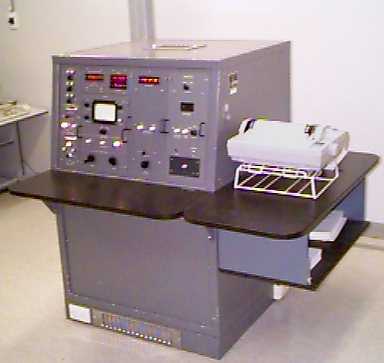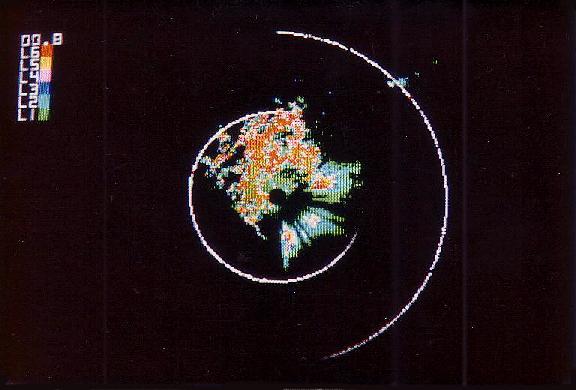The Bureau's first engineer, Geoff (Benny) Goodman, 1951- 1969, was to predict
the future direction of radar purchases in 1956 when he said that he thought
"5 or 6cm radar might offer a suitable compromise between the 3 and 10cm radar
now in common use." (1)
So in February 1981 the Bureau received its first C-band radar. It
was the prototype WF100-5C to be installed at Broadmeadows for acceptance testing
- a task that fell to Frank Cummings soon after his arrival from the Department
of Civil Aviation. This radar was the marrying by Enterprise Electronics Corporation
(Alabama USA) of their C-Band weather surveillance radar -WSR74C and their X-
band balloon tracking radar, the WF100-4X . Though fundamentally feasible, a
lot of work was necessary to fine tune the EEC design to achieve the required
performance levels. It was agreed at higher levels of Government to provide
EEC the Bureau designed solutions to the prototype's problems, rather than cancel
the contract and suffer the inherent massive delays in finding another radar
to meet the Bureau's urgent need to replace the aging 277F radars.
GENERAL DESCRIPTION
"The WF100-5C windfinder radar with meteorological option (MET/TRACK) consists
of a primary C-band windfinder radar with a meteorological color TV monitor
type display" is the description offered by the manufacturer in the technical
handbook. Though the transmitter and receiver offered no great technological
advancement apart from the use of transistor technology the extensive use of
TTL in the tracking system and the PPI presentation being a scan converted colour
TV style display was a great improvement on previous Bureau radars.
Integrating the microprocessor into the console
By December 1984, a program commenced to remove the standalone microprocessor
and replace them with a new Master Control Unit with an integrated microprocessor.
This used Bureau developed software and moved the small Datel printer to within
the Tracking Console.. This new software written by Alf West provided many improvements
in comparison to original units. These included the addition of an audio lost
target indication, preventing calculations whilst the radar is in MET mode as
well increasing its speed of operation.
Soon after this the Bureau decided to remove the Datel-Intersil Thermal printers
with its thermal paper from the console , which had a limited life, and use
cheaper Dot-matrix printers instead. For this new side benches were fitted onto
the Tracking Console and a new GPO had to be installed for the printer. This
was marked "RADAR PRINTER ONLY" so cleaners would not unplug the printer!
 |
WF100 Tracking Console with the integrated wind-calculating
microprocessor. The Bureau fitted dot-matrix printer is on the right of the console. |
THE WSR81C
GENERAL DESCRIPTION
The WSR81C radar was simply a WF100-5C system rearranged as a remote weather
watch radar system. It used the same basic transmitter/receiver/servo/antenna
with the linear receiver omitted, and a shepherd's hook horn feed in an 8 foot
antenna. A remote control system using the EEC binary synchronous format provided
the same colour TV style display as on the 'MET mode of the WF100. Control of
the transmitter, elevation angle and azimuth rotation rate was available at
the remote operator site via a small console..
 |
|
EEC 'MET' Display at WF100 or WSR81C
|
(1) Proceedings of the Tropical Cyclone Symposium, Brisbane December 1956)